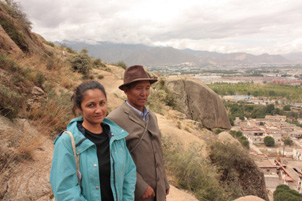Finding Lhasa |
The roof of the world. It is a cliché on beer labels, shop signs and restaurant menus. At 12,000 feet, Lhasa is one of the highest cities in the world but that is where its isolation ends. Johnny Cash twangs through speakers of the Summit Café serving French roast and internet instant messaging. Scantily clad Chinese lingerie models slither on billboards facing the old market.
Where is the Tibet of our dreams? Eastern or western, we superimpose our spiritual ideals upon the landscape of Tibet. The reality of Lhasa is another story.
On our last day Hugh and I decide to climb above Lhasa. We head into the hills above Sera Monastery which once housed five thousand monks at multiple colleges. Stale meat lingers in a plain kitchen painted black. Silver shafts of light illuminate blackened vats like half-moons. The fact that the kitchen worker doesn’t understand why we are there is why I love this humble place.
A half hour later we are climbing. A dapper Tibetan elder in a suit and hat is ahead of us. The pilgrim is showing us the way. Blood thickly circulates. The steep climb we share with livestock fills me with fear. He points to a modified phallic rock gesturing that people pray here. For children, for health--we cannot know. “Before they die, they build a house for the soul as it ascends to heaven,” Hugh tells me of the piled stones.
Breathless, we reach the saffron-stone hermitage built into a cliff face. It is partially burned. No one is there. Lhasa’s massive sprawl of government housing, rock quarries and military barracks are a thousand feet below.
The detonated earth shakes beneath us. Flocking vultures spread their wings as I lie down on the narrow path, exhausted by this balancing act. Will the raptors descend upon me thinking I am carrion? The Tibetans generously leave their unburied dead for them as the ultimate gesture of reconstitution, a comforting thought as I drift off.
We round the corner of the knife edge path. |
|
|

Blazing maroon boulders the size of trucks open up
a fluted valley and another narrow hermitage. “Should we look inside?” Hugh asks as he draws the stiff black door curtain back. Probably not, I reply as an ancient man emerges confused. Hugh says we should leave. I am certain he is beckoning us in.
We move slowly onto a bench of wool rugs. The old man is slurping a bowl of thick rotten cheese, the white substance rolling in his mouth. Deep chasms line his dark brow. He stares at us in silence. He pours two cups of yak butter tea. To refuse is an insult. “He is a hermit,” Hugh says. Thick, salty tea lines the inside of my throat and he refills our glasses twice more. The old man points to my bare legs. Quickly I spread my rain jacket across my thighs. He hums a lyric and spins the wheel clockwise. Time never goes backwards. The hermit stops, mouth open, staring. We are utterly alone.
After descending into blazing wheat fields late that afternoon and hitching a ride in a miniature army truck, Hugh and I begin to wonder about him, his isolation. He had a map of the world. Yet, he was up there for a reason.
“Think of all he has seen,” I said. The 1.2 million dead. The destruction of thousands of temples. The flight of the Dalai Lama and the abandonment of his country to outside forces. Suddenly it didn’t matter if we were the first or the last to see him. What mattered is that he had found us and through his silence we finally found Lhasa.
|